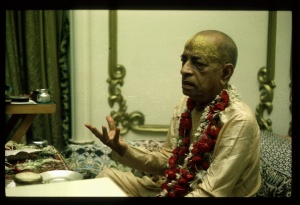SB 1.4.7 (1962)

A.C. Bhaktivedanta Swami Prabhupada
TEXT No. 7
Katham ba pandavayasya rajrsher munina saha
Sambadah samabhut tata yatra esha satwati shrutih.
ENGLISH SYNONYMS
Katham—how it is, ba—also, pandavayasya—of the descendant of Pandu (Parikshit), rajarshe—of the King who was a sage, munina—with the Muni, saha—along, sambadah—discussion, samabhut—took place, tata—darling, yatra—where upon, esha—like this, satwati—transcendental, shrutih—essence of the Vedas.
TRANSLATION
How it so happened that King Parikshit met the great sage and thus the great transcendental essence of Vedas (Bhagwatam) was possible to be sung by Him.
PURPORT
Srimad Bhagwatam is stated here as the essence of the Vedas. It is not an imaginary story as it is sometimes remarked by unauthorised men. It is also called Sukasamita or the Vedic hymn spoken by Sri Sukdeva Goswami the great liberated sage.